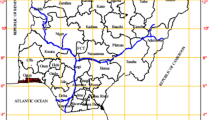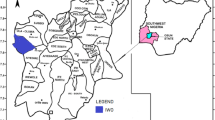Abstract
Tremendous variation exists in how cities, states, countries, and other jurisdictional areas classify water use and consumption. Additionally, water conservation measures have become more common in the past few decades, but little is known about how these conservation measures are implemented across the landscape. The goal of this study is to increase the breadth of knowledge regarding municipal water-use data: retention, storage, availability, and delving into water conservation measures, along with the impact of shale oil extraction on municipal water use in the Bakken region. Two questionnaires were developed and administered to all municipalities in the state of North Dakota, USA with populations greater than 1000 residents, and between 500 and 1000 residents in the Bakken region (total number (n) =59) willing to participate. Results indicate water conservation measures are inconsistent across the landscape, and data categorization at the municipal level is minimal which limits the analysis, interpretations, and projections that can be made from the data. Additionally, the Bakken region is different from the rest of the state in how they acquire water and sell water to other large scale users. Results from this study will aid water use professionals worldwide by providing valuable information on water-use data, access, storage, and impacts of large water users, such as shale oil extraction, on municipal water. This information will also help researchers to understand availability of data for making comparisons across different areas, assessing trends, and making water use projections.

Similar content being viewed by others
References
Arbués F, Garcıa-Valiñas MÁ, Martınez-Espiñeira R (2003) Estimation of residential water demand: a state-of-the-art review. J Socio-Econ 32(1):81–102
Averyt K, Macknick J, Rogers J, Madden N, Fisher J, Meldrum J, Newmark R (2013) Water use for electricity in the United States: an analysis of reported and calculated water use information for 2008. Environ Res Lett 8(1). https://doi.org/10.1088/1748-9326/8/1/015001
Balling RC Jr, Gober P (2007) Climate variability and residential water use in the city of Phoenix, Arizona. J Appl Meteorol Climatol 46(7):1130–1137
Bradley RM (2004) Forecasting domestic water use in rapidly urbanizing areas in Asia. J Environ Eng 130(4):465–471
Carter JM, Macek-Rowland KM, Thamke JN, Delzer GC (2016) Estimating National Water Use Associated with Unconventional Oil and Gas Development. US Geological Survey – Fact Sheet 2016–3032
Chang H, Parandvash GH, Shandas V (2010) Spatial variations of single-family residential water consumption in Portland, Oregon. Urban Geogr 31(7):953–972
Dieter CA, Maupin MA (2017) Public supply and domestic water use in the United States, 2015. U.S. Geological Survey Open-File Report 2017–1131
Environment Agency (2008) Water resources in England and Wales – current state and future pressures. The National Archives – UK Government. https://webarchive.nationalarchives.gov.uk/ 20140329213237/http://cdn.environment-agency.gov.uk/geho1208bpas-e-e.pdf. Accessed 24 January 2018
Environmental Working Group (EWG) (2018) WEG’s Tap Water Database: North Dakota. Environmental Working Group. https://www.ewg.org/tapwater/state.php?stab=ND#. W6uJGXtKiUk. Accessed 12 September 2018
Fielding KS, Spinks A, Russell S, McCrea R, Stewart R, Gardner J (2013) An experimental test of voluntary strategies to promote urban water demand management. J Environ Manag 114:343–351
Gleick PH (2003) Water use. Annu Rev Environ Resour 28(1):275–314
Gleick PH, Palaniappan M (2010) Peak water limits to freshwater withdrawal and use. Proc Natl Acad Sci U S A 107(25):11155–11162
Grimmond CSB, Oke TR (1986) Urban water balance: 2. Results from a suburb of Vancouver. British Columbia Water Resour Res 22(10):1404–1412
Halich G, Stephenson K (2009) Effectiveness of residential water-use restrictions under varying levels of municipal effort. Land Econ 85(4):614–626
Hauber-Davidson G, Idris E (2006) Smart water metering. Water 33(3):38–41
Horner RM, Harto CB, Jackson RB, Lowry ER, Brandt AR, Yeskoo TW, Murphy DJ, Clark CE (2016) Water use and management in the Bakken shale oil play in North Dakota. Environ Sci Technol 50(6):3275–3282
House-Peters L, Pratt B, Chang H (2010) Effects of urban spatial structure, Sociodemographics, and climate on residential water consumption in Hillsboro, Oregon. J Am Water Resour Assoc 46(3):461–472
Kenney DS, Klein RA, Clark MP (2004) Use and effectiveness of municipal water restrictions during drought in Colorado. J Am Water Resour Assoc 40(1):77–87
Kenny JF, Juracek KE (2012) Description of 2005–10 domestic water use for selected US cities and guidance for estimating domestic water use. US Geological Survey Scientific Investigations Report, 2012–5163
Kim JR, McCuen RH (1979) Factors for predicting commercial water use. J Am Water Resour Assoc 15(4):1073–1080
Kostas B, Chrysostomos S (2006) Estimating urban residential water demand determinants and forecasting water demand for Athens metropolitan area, 2000-2010. SE Eur J Econ 1(1):47–59
Lin Z, Lin T, Lim SH, Hove MH, Schuh WM (2018) Impacts of Bakken shale oil development on regional water uses and supply. J Am Water Resour Assoc 54(1):225–239
Loaiciga HA, Renehan S (1997) Municipal water use and water rates driven by severe drought: a case study. J Am Water Resour Assoc 33(6):1313–1326
Lyman RA (1992) Peak and off-peak residential water demand. Water Resour Res 28(9):2159–2167
Maupin MA, Kenny JF, Hutson SS, Lovelace JK, Barber NL, Linsey KS (2014) Estimated Use of Water in the United States in 2010. U.S. Geological Survey Circular 1405
McKenzie R, Houston B (2011) Implementing automatic meter readings for water: a reflective approach to weighing options. Florida Water Resour J. http://fwrj.com/techarticles/0811%20tech1.pdf. Accessed 2 September 2018
Mini C, Hogue TS, Pincetl S (2014) Estimation of residential outdoor water use in Los Angeles, California. Landsc Urban Plan 127:124–135
Mini C, Hogue TS, Pincetl S (2015) The effectiveness of water conservation measures on summer residential water use in Los Angeles, California. Resour Conserv Recycl 94:136–145
Morales MA, Martin JM, Heaney JP (2009) Methods for Estimating Commercial, Industrial and Institutional Water Use. In Proceedings of FSAWWA Water Conference Orlando. http://www.conservefloridawater.org/publications/10327351.pdf. Accessed 15 February 2017
National Oceanic and Atmospheric Administration (NOAA) (2018) Climate of North Dakota. National Oceanic and Atmospheric Administration. https://search.usa.gov/search?utf8=%E2%9C%93&affiliate=noaa.gov&query=north+dakota+average+temparture. Accessed 27 September 2018
North Dakota Century Code (NDCC) § 61–04 Appropriation of Water. North Dakota Legislative Branch. https://www.legis.nd.gov/cencode/t61c04.pdf#nameddest=61-04. Accessed 10 June 2018
North Dakota Department of Health (NDDoH) (2006) Arsenic trioxide superfund site fact sheet. North Dakota Department of Health. https://deq.nd.gov/publications/wq/1_GW/Arsenic/ArsenicTrioxideSuperfundSiteFactSheet.pdf. Accessed 12 September 2018
North Dakota Department of Health (NDDoH) (2015) Uranium in drinking water fact sheet. North Dakota Department of Health. https://deq.nd.gov/publications/wq/1_GW/Uranium/UraniumInDrinkingWaterFactSheet.pdf. Accessed 12 September 2018
North Dakota Industrial Commission Department of Mineral Resources Oil and Gas Division (NDIC) (2010) Oil in North Dakota – 2010 production statistics. North Dakota Oil and Gas. https://www.dmr.nd.gov/oilgas/stats/AnnualProduction/2010AnnualProductionReport.pdf. Accessed 23 March 2017
North Dakota Industrial Commission Department of Mineral Resources Oil and Gas Division (NDIC) (2011) Oil in North Dakota – 2011 production statistics. North Dakota Oil and Gas. https://www.dmr.nd.gov/oilgas/stats/AnnualProduction/2011AnnualProductionReport.pdf. Accessed 23 March 2017
North Dakota Industrial Commission Department of Mineral Resources Oil and Gas Division (NDIC) (2012) Oil in North Dakota – 2012 production statistics. North Dakota Oil and Gas. https://www.dmr.nd.gov/oilgas/stats/AnnualProduction/2012AnnualProductionReport.pdf. Accessed 23 March 2017
North Dakota Industrial Commission Department of Mineral Resources Oil and Gas Division (NDIC) (2013) Oil in North Dakota – 2013 production statistics. North Dakota Oil and Gas. https://www.dmr.nd.gov/oilgas/stats/AnnualProduction/2013AnnualProductionReport.pdf. Accessed 23 March 2017
North Dakota State Water Commission (2019) North Dakota State Water Commission Water Permits Database. http://www.swc.nd.gov/info_edu/map_data_resources/waterpermits/. Accessed 10 Sept. 2019
Polebitski AS, Palmer RN (2010) Seasonal residential water demand forecasting for census tracts. J Water Resour Plan Manag 136(1):27–36
Qi C, Chang NB (2011) System dynamics modeling for municipal water demand estimation in an urban region under uncertain economic impacts. J Environ Manag 92(6):1628–1641
Roberts KD (1992) A survey of naturally occurring uranium in groundwater in southwestern North Dakota. North Dakota Department of Health. https://deq.nd.gov/publications/wq/1_GW/Uranium/UraniumStudy_SW_NDGroundwater.pdf. Accessed 12 September 2018
Shipton D, Tappin DM, Vadiveloo T, Crossley JA, Aitken DA, Chalmers J (2009) Reliability of self reported smoking status by pregnant women for estimating smoking prevalence: a retrospective, cross sectional study. BMJ 339. https://doi.org/10.1136/bmj.b4347
United States Census Bureau (USCB) (2019) United States Census Bureau Quick Facts North Dakota. https://www.census.gov/quickfacts/ND. Accessed 23 October 2019
Wong ST (1972) A model on municipal water demand: a case study of northeastern Illinois. Land Econ 48(1):34–44
Wong JS, Zhang Q, Chen YD (2010) Statistical modeling of daily urban water consumption in Hong Kong: trend, changing patterns, and forecast. Water Resour Res 46(3). https://doi.org/10.1029/2009WR008147
Yi L, Jiao W, Chen X, Chen W (2011) An overview of reclaimed water reuse in China. J Environ Sci 23(10):1585–1593
Zhou SL, McMahon TA, Walton A, Lewis J (2000) Forecasting daily urban water demand: a case study of Melbourne. J Hydrol 236(3–4):153–164
Acknowledgements
Authors would like to thank United States Geological Survey for funding; as well as the United States Department of Agriculture National Institute of Food and Agriculture, Hatch project number ND02396. Additional thanks to Kathie Rowland, Bill Schuh for their guidance and Amy Gnoinsky and Savannah Fritz for assistance on the project.
Statement of Contributed
All authors contributed to the design of the study. The study was part of Nicole Ellingson’s Master of Science thesis work, advised by Christina Hargiss. Christina Hargiss wrote the proposal for funding, Nicole Ellingson conducted data collection and analysis with assistance from Jack Norland. The first draft of the manuscript was written by Nicole Ellingson and all authors commented, edited, and contributed to final document. All authors approve of the final manuscript.
Author information
Authors and Affiliations
Corresponding author
Ethics declarations
Conflict of Interest
None.
Additional information
Publisher’s Note
Springer Nature remains neutral with regard to jurisdictional claims in published maps and institutional affiliations.
Rights and permissions
About this article
Cite this article
Ellingson, N., Hargiss, C.L.M. & Norland, J. Understanding Municipal Water Use and Data Availability: a Case Study across North Dakota, USA. Water Resour Manage 33, 4895–4907 (2019). https://doi.org/10.1007/s11269-019-02411-8
Received:
Accepted:
Published:
Issue Date:
DOI: https://doi.org/10.1007/s11269-019-02411-8




